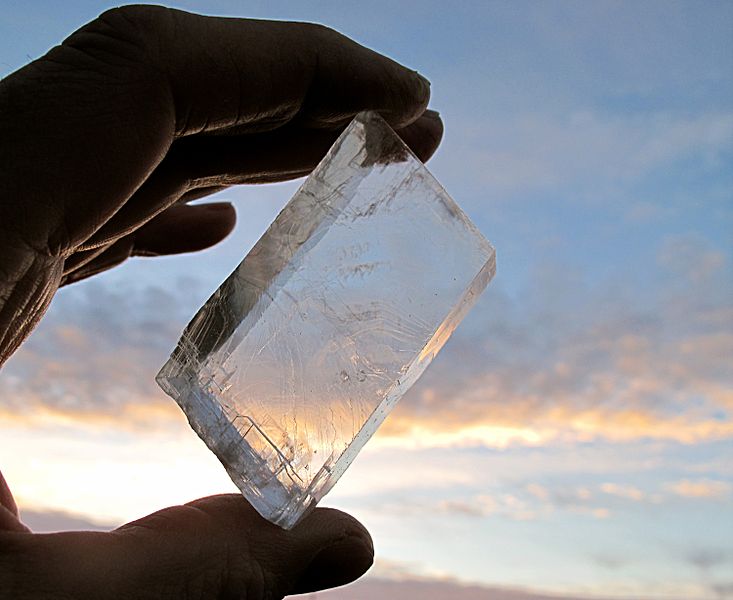
Fans of the TV mini-series Dinotopia know that sunstones are the energy source that keeps society ticking over and the Tyrannosaurus Rex at bay. But far from being the invention of a fantasy writer’s imagination, a crystal with the mythical properties of this mysterious mineral does exist and knowledge of it goes back as far as Viking times.
It is believed that the seafaring nation used what they called a solarsteinn to navigate after sunset and on days when heavy cloud obscured the sun. Today it is called Icelandic spar and it is found in quantity on Icelandic shores.
The sunstone unerringly found the position of the sun when the human eye could not. The Vikings were magnificent navigators who used a variety of methods to navigate the ocean, such as sundials, stars, geological features and migrating birds to guide them to land. But how could they navigate darkened skies and stormy seas without these aids?
The magnetic compass had not been invented and yet they reached places as far as Newfoundland. The Icelandic spar, or sunstone, seems to hold the answer – a calcite crystal that could pinpoint the sun even when it wasn’t visible to the naked eye.
Finally….some proof!
The discovery of a rhombohedral (six-sided) shard of Icelandic Spar, which was found in 2002 on the wreck of the Elizabethan warship Alderney, has caused a controversy that sparked a new quest to prove the existence of sunstones as navigational aids. The ship sank off the Channel Islands between Britain and France in 1592, when magnetic compasses had come into use.
The crystal was found among navigation items, which suggested that it was used as a backup when the heavy iron cannons on board interfered with the magnetic compass. Such crystals are well known to create double images through the rhombohedral shape by an optical property called birefringence, or splitting light. When moved into the right position, the two images become one as the crystal aligns to east and west.
The Alderney crystal was tested by physicist Guy Ropars, of the French University of Rennes, who used a laser light to focus on the crystal, measuring how it separated polarized from non-polarized light. Ropars and his laboratory team found that by rotating the crystal, that there was one point where a single image appeared and the crystal was perfectly aligned. It all depended on the angle of the beam of light. If Viking navigators used sunstones, this is how they would have found the sun.
Later experiments by Ropars and his team have shown that housing the sunstone in a simple device makes the operation simpler. Light enters through a tiny hole in the device, a small wooden cylinder, which can be easily rotated to fix the direction of the sun to within 1 degree of accuracy. But still physical evidence of such a device, or the sunstones, at a Viking location, remain elusive.
Is There A Viking Condition?
A smaller shard was discovered at a Viking settlement dig site in 2012, but no whole crystals have ever been found at Viking sites. This is possibly because Vikings, and their belongings, were usually incinerated after death and Icelandic Spar shatters in intense heat. But the crystal discovered on the Alderney shows that this method was known even after the invention of the compass. But was it used for back-up navigation, or kept as an amusing toy? Would it actually work at sea?.
In 2007, a team of researchers from Eotvos University in Budapest, led by biophysicist Gabor Horvath, set sail aboard the Swedish icebreaker Oden to test the myth and find out if sunstones could really find the sun when it was out of sight. What they found confirmed the myth yet again, under sea-going conditions.
The team was able to find the sun in cloudy weather with a very close degree of accuracy. In spite of this research, many present day experts still insist that the sunstone is an enduring myth that began in the adventurous, romantic and probably fictional Viking sagas..
In the Saga of St Olaf, a manuscript from the 13th Century, the Hero Sigurd and King Olaf Haraldsson discuss the position of the sun on a cloudy day. When Sigurd pointed to the sun, King Olaf picked up a sunstone and found the position himself. In the Hrafns Saga another King used a sunstone in stormy weather and ‘saw where the sun beamed from the stone’.
In light of current research, it is possible these things were not magical fantasy but existing objects in daily use.
The use of polarized light for navigation is nothing new in nature – butterflies and birds use it to find their way around. It is not so far-fetched to speculate that humans have used it too.
Thanks to the discovery of the Alderney sunstone, the ability of Icelandic spar to almost accurately pinpoint a source of light is no longer challenged. But whether the Vikings – or anyone else – used sunstones for navigation remains a moot question.